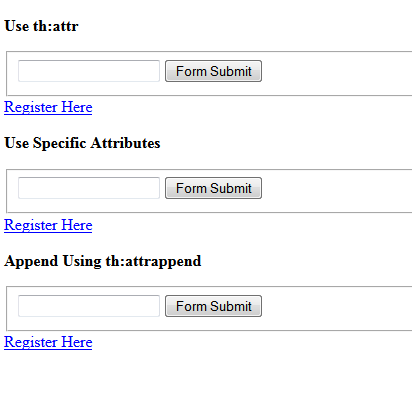In my previous articles I have explained about the hello world example and the expression language. This tutorial explains how to set the attribute to the template at the time of processing. This feature is very useful for creating the templates. Thymeleaf provides very easy syntax for just adding the attributes dynamically from the properties files or context variables.
1. Set Up Thymeleaf Application
To demonstrate using the attribute values, I am using our previous hello world example.Use the same example and replace our code snippet below.
2. Create Template with th:attr
If you look at the below example, the tamplate has the th:attr which is replaced with the dynamic values by the template engine. Note that there are number of attributes and many other features are supported for setting the attribute values. Here I am explaining with a very simple example.
attributes.html
<!DOCTYPE html SYSTEM "http://www.thymeleaf.org/dtd/xhtml1-strict-thymeleaf-4.dtd">
<html xmlns="http://www.w3.org/1999/xhtml"
xmlns:th="http://www.thymeleaf.org">
<head>
<title>How to set Attribute Values!!</title>
<meta http-equiv="Content-Type" content="text/html; charset=UTF-8" />
</head>
<body>
<p><b>Use th:attr</b></p>
<fieldset>
<input type="text" name="email" th:attr="class=#{input.class}"/>
<input type="submit" value="Subscribe me!" th:attr="value=#{input.submit}"/>
</fieldset>
<a href="register.html" th:attr="href=@{/LoginRegister.html}">Register Here</a>
<p><b>Use Specific Attributes</b></p>
<fieldset>
<input type="text" name="email" th:class="#{input.class}"/>
<input type="submit" value="Subscribe me!" th:value="#{input.submit}"/>
</fieldset>
<a href="register.html" th:href="@{/LoginRegister.html}">Register Here</a>
<p><b>Append Using th:attrappend</b></p>
<fieldset>
<input type="text" name="email" class="input" th:attrappend="class=' ' + #{input.class}"/>
<input type="submit" value="Subscribe me!" th:attr="value=#{input.submit}"/>
</fieldset>
<a href="register.html" th:attr="href=@{/LoginRegister.html}">Register Here</a>
</body>
</html>
3. Create Servlet with Thymeleaf Context and Attach Template
ThymeleafSetAttributeExample.java
package javabeat.net.thymeleaf;
import java.io.IOException;
import java.util.ArrayList;
import java.util.Calendar;
import java.util.TreeSet;
import javax.servlet.ServletException;
import javax.servlet.http.HttpServlet;
import javax.servlet.http.HttpServletRequest;
import javax.servlet.http.HttpServletResponse;
import org.thymeleaf.TemplateEngine;
import org.thymeleaf.context.WebContext;
import org.thymeleaf.templateresolver.ServletContextTemplateResolver;
public class ThymeleafSetAttributeExample extends HttpServlet{
@Override
protected void doGet(HttpServletRequest req, HttpServletResponse resp)
throws ServletException, IOException {
ServletContextTemplateResolver templateResolver = new ServletContextTemplateResolver();
// XHTML is the default mode, but we will set it anyway for better understanding of code
templateResolver.setTemplateMode("XHTML");
templateResolver.setPrefix("/WEB-INF/");
templateResolver.setSuffix(".html");
templateResolver.setCacheTTLMs(3600000L);
TemplateEngine templateEngine = new TemplateEngine();
templateEngine.setTemplateResolver(templateResolver);
WebContext ctx = new WebContext(req, resp, getServletConfig().getServletContext(), req.getLocale());
// This will be prefixed with /WEB-INF/ and suffixed with .html
templateEngine.process("attribute", ctx, resp.getWriter());
resp.setContentType("text/html;charset=UTF-8");
resp.setHeader("Pragma", "no-cache");
resp.setHeader("Cache-Control", "no-cache");
resp.setDateHeader("Expires", 1000);
}
}
4. Create Property File
attributes_en.properties/strong>
input.class=inputstyle input.submit=Form Submit input.href=LoginRegister.html
5. Run The Thymeleaf Application
If you execute the above code, you would see the below screen.

If you look at the view source, the above template converted as below.
<!DOCTYPE html PUBLIC "-//W3C//DTD XHTML 1.0 Strict//EN"
"http://www.w3.org/TR/xhtml1/DTD/xhtml1-strict.dtd">
<html xmlns="http://www.w3.org/1999/xhtml">
<head>
<title>How to set Attribute Values!!</title>
<meta http-equiv="Content-Type" content="text/html; charset=UTF-8" />
</head>
<body>
<p><b>Use th:attr</b></p>
<fieldset>
<input type="text" name="email" class="inputstyle" />
<input type="submit" value="Form Submit" />
</fieldset>
<a href="/Thymeleaf/LoginRegister.html" shape="rect">Register Here</a>
<p><b>Use Specific Attributes</b></p>
<fieldset>
<input type="text" name="email" class="inputstyle" />
<input type="submit" value="Form Submit" />
</fieldset>
<a href="/Thymeleaf/LoginRegister.html" shape="rect">Register Here</a>
<p><b>Append Using th:attrappend</b></p>
<fieldset>
<input type="text" name="email" class="input inputstyle" />
<input type="submit" value="Form Submit" />
</fieldset>
<a href="/Thymeleaf/LoginRegister.html" shape="rect">Register Here</a>
</body>
</html>

 Get URL Content using Java
Get URL Content using Java